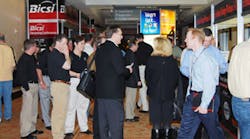At the BICSI 2008 Winter Conference, held January 14-17 at the Gaylord Resort and Conference Center in Orlando, Fla., more than 5,500 members, guests, and vendors learned about the opportunities and challenges facing the information technology systems (ITS) industry in this period of economic uncertainty. Attendees also reviewed the growing array of high-performance copper and fiber cable, connectivity hardware, and cable management solutions for applications that vary widely from the data center to the desktop. Understandably, the data center continues to be a key area of focus for conservation and improved energy efficiency, as indicated by the variety of vendor offerings, such as power management and cooling methods around the servers.
On the association front, BICSI is modernizing its credentialing process to elevate the importance of the existing Registered Communications Distribution Designers (RCDD). It will also make the RCDD and Specialty programs more readily available to IT, engineering, and other professionals, as well as modernize the credentialing programs to bring them in line with other professional credentialing systems.
Pre-conference session highlights
In “Intelligent Business Campuses: Keys to Future Economic Developments,” James Carlini, Carlini & Associates, Inc., East Dundee, Ill., spotlighted the economic advantages that broadband (not less than 1 Gbps) connectivity offers to regions and municipalities. To be competitive, these government entities must offer this critical infrastructure or suffer economic decline. Carlini offered one example of how investment in infrastructure can spark growth. Fort Wayne, Ind., has been re-building its communications systems since 2000, with a heavy investment in wireless and fiber distribution. In conjunction with this investment, the city's population increased from 190,000 in 1999 to 252,000 in 2006, the non-public safety employee level grew from 936 to 950, and the miles of roads to be maintained increased by 41%.
In “What the RCDD Needs to Know about the NEC 2005,” Santiago Beron and David Southwick, TLC Engineering, Tampa, Fla., discussed the pertinent articles that relate to the design of voice/data, security/safety, and audio/visual systems in buildings. New requirements adopted in the 2008 NEC were also reviewed, including:
-
Network-powered broadband communications systems must comply with Art. 830 [800.3(C)].
-
Rules for unlisted outside plant communications cables entering buildings [800.48].
-
Listed riser communications raceways and listed plenum communication raceways as being acceptable for use in other areas within buildings in addition to plenums and risers [800.154(C)(1)].
-
Fire alarm system conductors must comply with 300.8.
-
NPLFA and PLFA power sources must be supplied by an individual branch circuit [760.41 and 760.121].
-
NPLFA and PLFA cables used in wet locations must be listed for use in wet locations or have a moisture-impervious metal sheath [760.176 and 760.179].
In “What Is Involved in an AV System?” Eric Marshall, Consultant, Modesta, Calif., discussed the topic of sources, how to connect them to the media outputs, and how to improve or change the signals. Marshall emphasized that an audio system is more than microphones, processors, and speakers. In fact, he said that an unsuccessful installation is often the result of not understanding system levels and gain structure.
Conference session highlights
In “There's No Place Like Home: Troubleshooting the Premise-Enterprise & In-Home Wiring Solutions,” Assaji Aluwihare, JDSU, Milpitas, Calif., reviewed new technologies, such as IP video and whole-home DVRs, emphasizing that with computers and digital media becoming more central to family life, the need to organize, share and protect digital content becomes more important. Thus, a home network with high bandwidth that is able to support new applications, such as remote monitoring and security, is now required.
Although Cat. 5/Cat. 6 UTP Ethernet network cabling is a desirable way to deliver this bandwidth, very few homes have this type of wiring. Therefore, the existing wiring in a home — coaxial cable, telephone cable, or electrical power circuits — are the likely candidates, with each medium providing different economic and performance trade-offs, Aluwihare observed. The three alternatives to Cat. 5/Cat. 6 rewiring are:
-
Coaxial cable: The Multimedia over Coax Alliance (MoCA) promotes the use of the existing coaxial cable in a home.
-
Phone cable: The Home Phoneline Alliance Version 3 (HPNAv3) also promotes the use of the existing coaxial cable and/or the existing telephone cable in a home. AT&T is using HomePNAv3 for its home networking to support its Fiber-fed U-verse data and television services, and its copper-fed AT&T Yahoo DSL high-speed Internet service.
-
Power cable: HomePlug AV promotes the use of the AC electric power branch circuits in a home for distribution. The latest version of the technology (200Mbps) is aimed at carrying data that requires broadband speeds and guaranteed Quality of Service (QoS), such a high-definition video. In addition, the HomePlug AV's algorithm — the basis for the technology — works just as well on telephone wiring and coax. The HomePlug Alliance Board of Directors recently ratified the HomePlug C&C 1.0 specification to provide command and control applications for electric energy loads in the home, since energy conservation and management of loads is of growing importance to electric utilities.
Why not go wireless? Wireless is often mentioned as a networking method in the home, but generally it has been rejected by service providers, due to concerns about loss of signal and interference from other wireless transmissions.
“Exploring Issues Associated with the Migration to Intelligent Information Networks,” presented by Jim Serenbetz, Anixter, Glenview, Ill., addressed the growth occurring in the integration of various building services into a unified control and monitoring network. Such integration improves the building environment and adds value for the owners, the facility managers, and its occupants. For this value proposition, the business drivers are: centralized management, ease of regulatory compliance (Sarbanes-Oxley), lower operating costs, conservation initiatives (green buildings and LEED certification), and increased worker productivity and mobility. The technologies being specified in buildings include: communications systems for voice, data, and video; security systems, such as video cameras and access control systems (e.g., identification card readers to open doors); fire and life safety systems, such as smoke alarms, carbon dioxide detectors, audio alarms, and visual fire-alerts; lighting control systems (including photoelectric daylight sensors, occupancy sensors, and dimming systems); HVAC control systems; and energy monitoring systems. The two technology forces making this possible are the use of the Ethernet protocol for data networks in a building, and the convenience of having IP addresses for all endpoints (sensors and control devices) using the Internet Protocol (IP).
A basic concept in promoting the intelligent building is different systems can share the same wiring, thus lowering the cost for each system in the network. The average cost savings for new multi-system networks, based on the estimate of a major control installation contractor, is 10% per system (beyond one system). These savings can be as high as 20% per system for installations in existing buildings for which retrofit wiring is difficult. In all cases, consult local codes with respect to sheath sharing. Serenbetz noted that the added initial cost of integrated control systems saves operating costs over the building's lifetime and also provides satisfied tenants (individual control of temperature/lighting at a work station). From a safety perspective, a fire detection system, interconnected to the HVAC system, can ventilate smoke outside — allowing doors to be unlocked for egress. Standards, such as EIA/TIA 776-5 on Building Automation and Control, TIA/EIA 862 on Building Automation Systems, and NFPA 731 on Installation of Electronic Premises Security Systems, are among the key drivers in these efforts.




